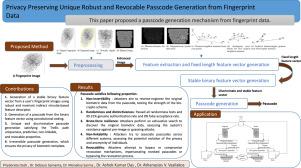隐私保护独特的健壮和可撤销的密码从指纹数据生成
IF 5.4
2区 计算机科学
Q1 COMPUTER SCIENCE, INFORMATION SYSTEMS
引用次数: 0
摘要
本研究探索从指纹图像生成密码。研究通过三个步骤展开:(a)从细节特征生成固定长度特征向量,(b)从固定长度特征向量生成稳定二进制特征向量,以及(c)从稳定二进制特征向量生成密码。这项工作的主要研究目标是:(1)如何从指纹图像中生成唯一且鲁棒的二进制模式,(2)如何从该二进制位模式中生成满足不可链接和可撤销属性的密码,以及(3)攻击者如何在给定密码的情况下无法猜测源生物特征,从而保护指纹数据的隐私。生成的密码可以应用于许多应用,如无需注册认证的唯一身份生成、网络安全的加密密钥生成、远程认证协议或分布式系统、数据存储安全、数字钱包等。该方法已在FVC2002和FVC2004中进行了验证,结果显示真实接受率为99.31%和99.25%,错误接受率为0%。此外,生成的密码通过了NIST和Diehard随机性测试,证实了具有高内部相似度和低内部相似度的潜在密钥生成技术。本文章由计算机程序翻译,如有差异,请以英文原文为准。

Privacy preserving unique robust and revocable passcode generation from fingerprint data
This research explores generating passcodes from fingerprint images. The investigation unfolds through a three-step process: (a) fixed length feature vector generation from minutia features, (b) stable binary feature vector generation from the fixed length feature vector, and (c) passcode generation from the stable binary feature vector. The main research objectives of this work are: (1) how a unique and robust binary pattern can be generated from a fingerprint image, (2) from this binary bit pattern, how a passcode can be generated satisfying non-linkable and revocable properties, and (3) how an attacker cannot guess the source biometric given a passcode thus preserving the privacy of the fingerprint data. The generated passcode can be applied in many applications, such as unique identity generation for authentication without enrollment, encryption key generation for network security, remote authentication protocol or distributed systems, data storage security, digital wallet, etc. The proposed approach has been validated with FVC2002 and FVC2004, and results show impressive genuine acceptance rates of 99.31% and 99.25%, with 0% false acceptance rates. Further, the generated passcodes pass NIST and Diehard randomness tests, substantiating the potential key generation technique with high intra-similarity and low inter-similarity.
求助全文
通过发布文献求助,成功后即可免费获取论文全文。
去求助
来源期刊

Computers & Security
工程技术-计算机:信息系统
CiteScore
12.40
自引率
7.10%
发文量
365
审稿时长
10.7 months
期刊介绍:
Computers & Security is the most respected technical journal in the IT security field. With its high-profile editorial board and informative regular features and columns, the journal is essential reading for IT security professionals around the world.
Computers & Security provides you with a unique blend of leading edge research and sound practical management advice. It is aimed at the professional involved with computer security, audit, control and data integrity in all sectors - industry, commerce and academia. Recognized worldwide as THE primary source of reference for applied research and technical expertise it is your first step to fully secure systems.
 求助内容:
求助内容: 应助结果提醒方式:
应助结果提醒方式:


